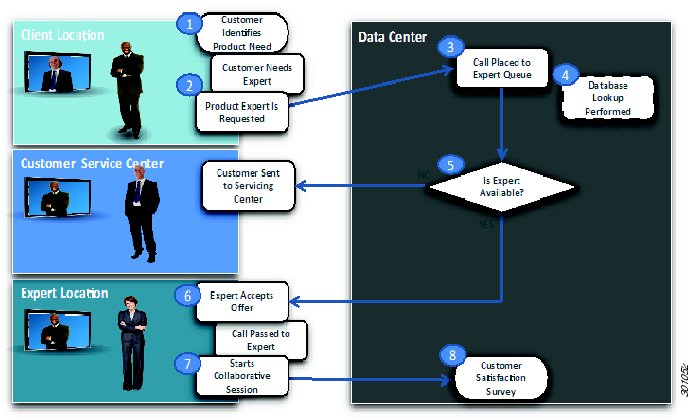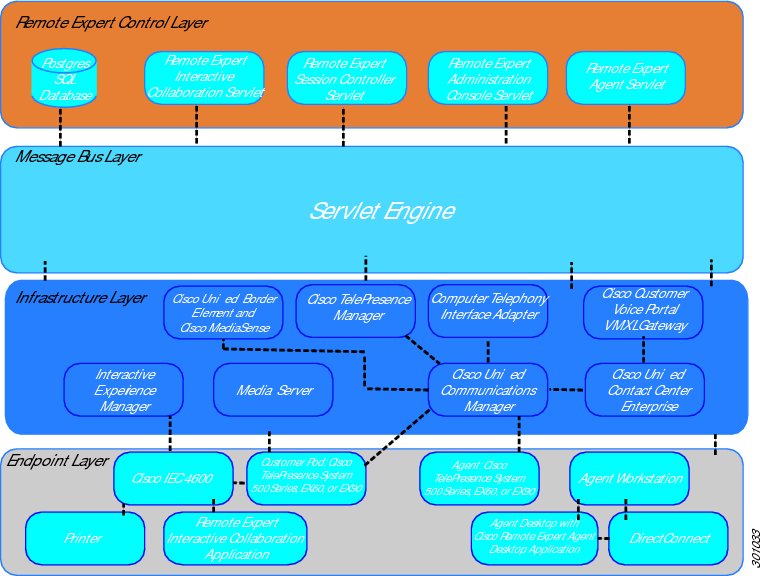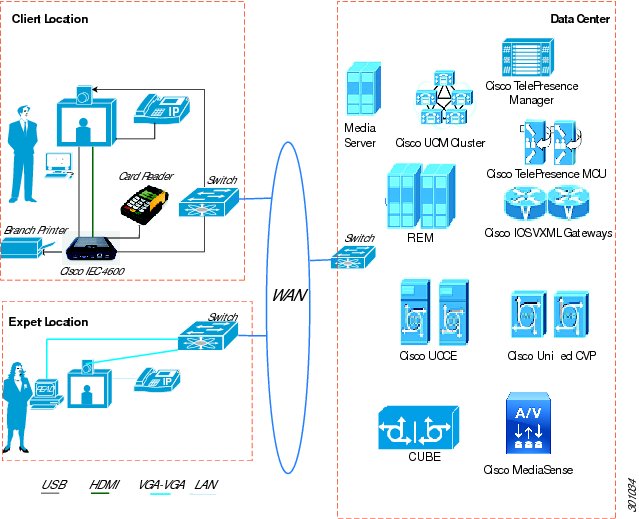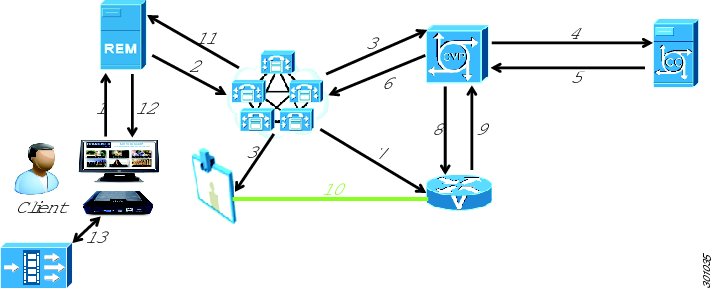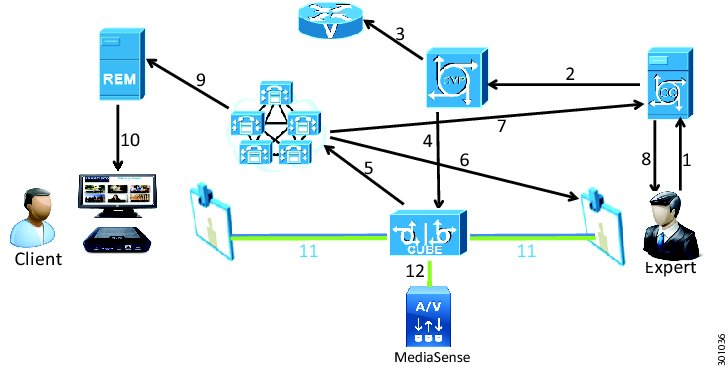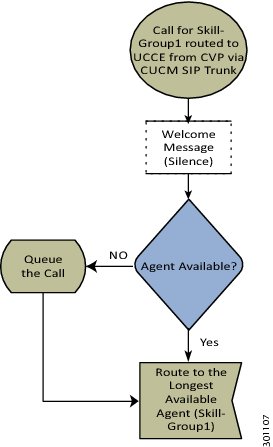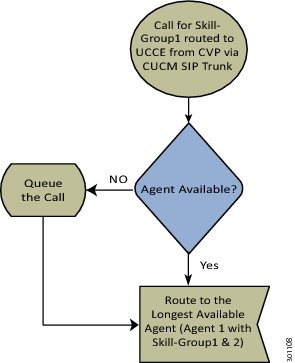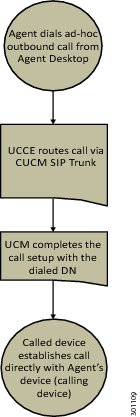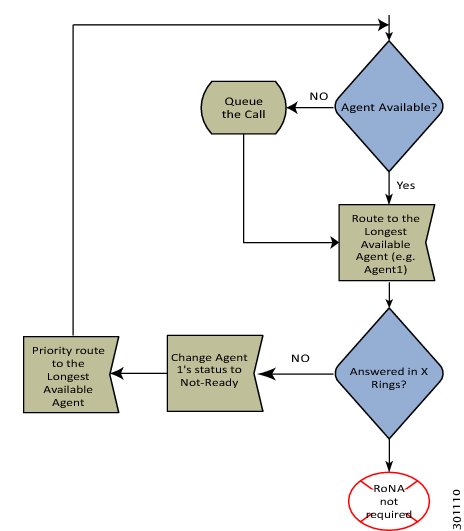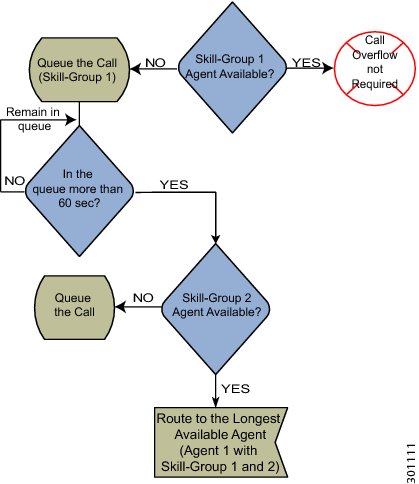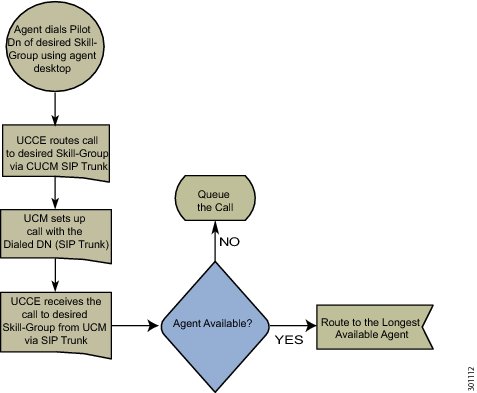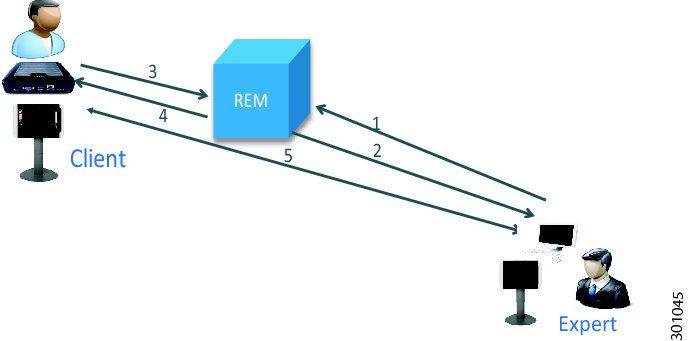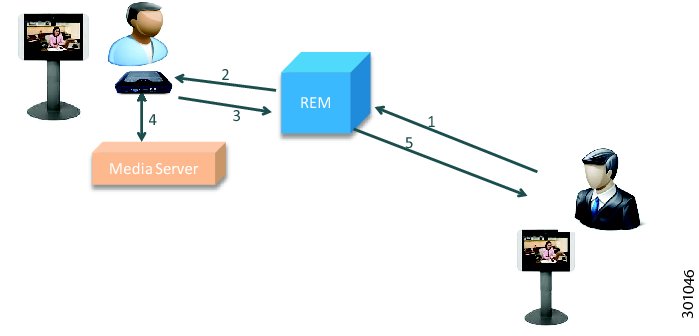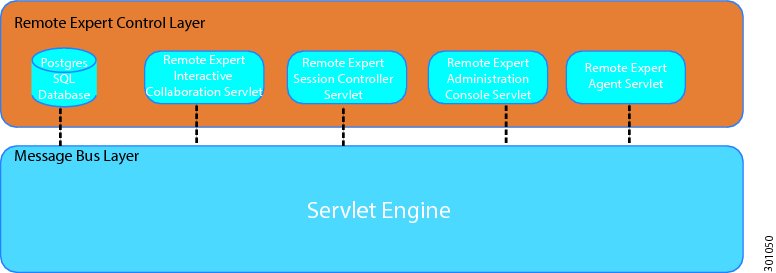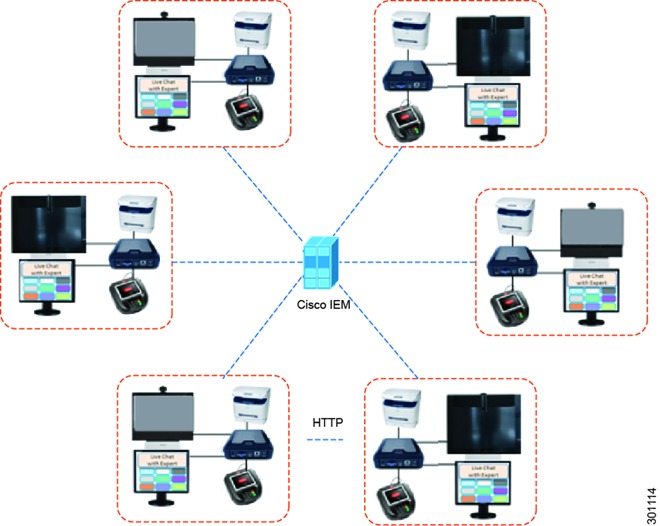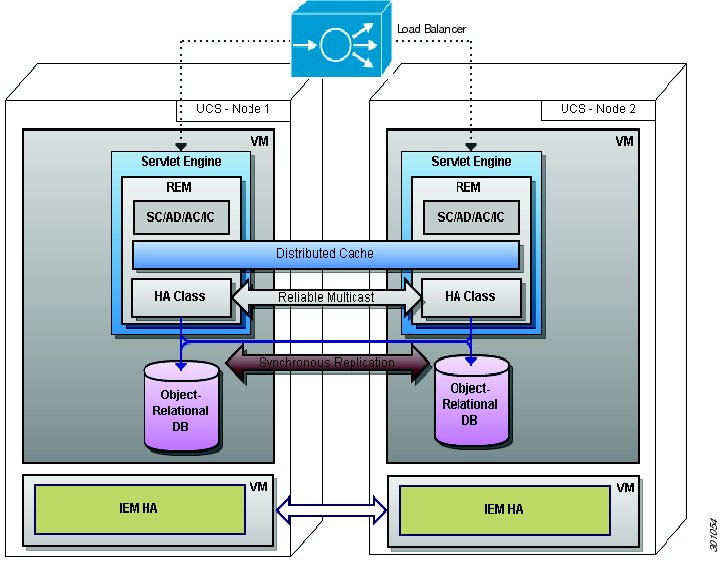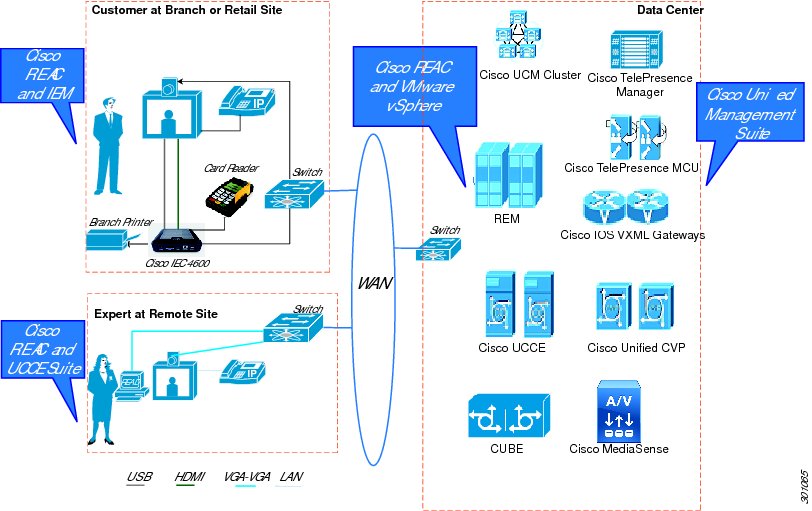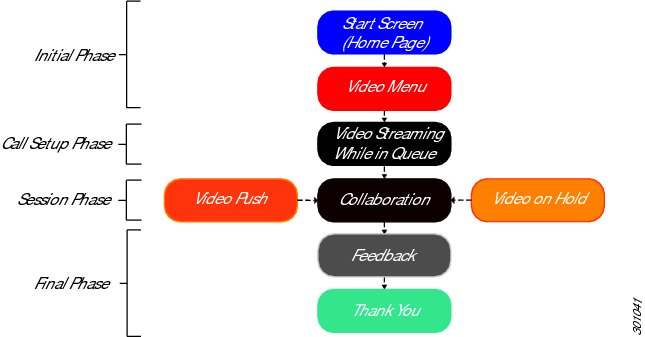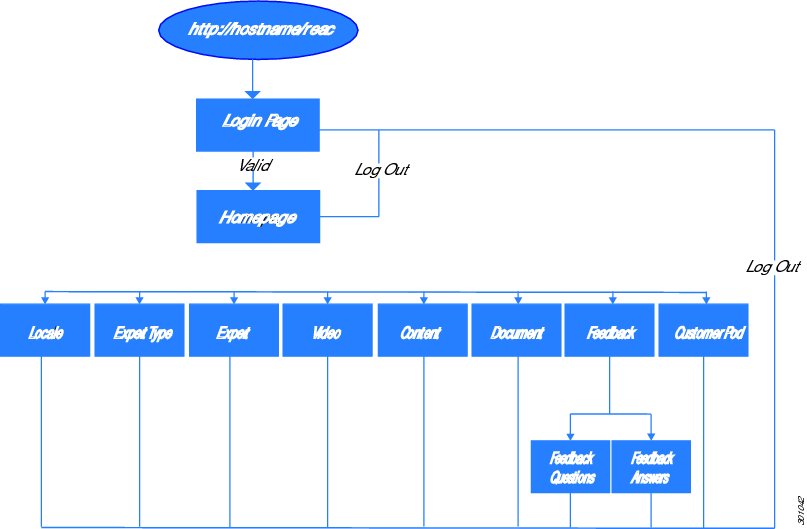 Feedback Feedback
|
Table Of Contents
Cisco Validated Design for the Remote Expert Smart Solution 1.8
About Cisco Validated Design (CVD) Program
Cisco Remote Expert Smart Solution Vision
Need for the Cisco Remote Expert Smart Solution
Cisco Remote Expert Smart Solution Workflow at the Customer Location
Cisco Remote Expert Smart Solution Use Cases
Cisco Remote Expert Smart Solution Architecture
Cisco Remote Expert Smart Solution Functional Architecture
Automatic Call Director (ACD) Considerations for the Remote Expert Smart Solution
Desktop Collaboration Call Flow
4 Cisco Remote Expert Smart Solution Deployment Model
Unified Communications Management
Long-Term Storage Considerations for Cisco MediaSense Recordings
Cisco Remote Expert Smart Solution Core Applications
Cisco Remote Expert Manager High Availability
5 Cisco Remote Expert Smart Solution End-to-End Design Considerations
6 Cisco Remote Expert Solution Operations and Management
Cisco Remote Expert Smart Solution Management and Operations Architecture
High Availability of Management Applications
Cisco Remote Expert Smart Solution Customization
Cisco Remote Expert Smart Solution Management Tools Summary
Cisco Remote Expert Smart Solution Management Tools
Cisco Remote Expert Administration Console
Cisco Interactive Experience Manager
Cisco Validated Design for the Remote Expert Smart Solution 1.8
August 21, 2013
Contents
About Cisco Validated Design (CVD) Program
The CVD program consists of systems and solutions designed, tested, and documented to facilitate faster, more reliable, and more predictable customer deployments. For more information visit http://www.cisco.com/go/designzone.
ALL DESIGNS, SPECIFICATIONS, STATEMENTS, INFORMATION, AND RECOMMENDATIONS (COLLECTIVELY, "DESIGNS") IN THIS MANUAL ARE PRESENTED "AS IS," WITH ALL FAULTS. CISCO AND ITS SUPPLIERS DISCLAIM ALL WARRANTIES, INCLUDING, WITHOUT LIMITATION, THE WARRANTY OF MERCHANTABILITY, FITNESS FOR A PARTICULAR PURPOSE AND NONINFRINGEMENT OR ARISING FROM A COURSE OF DEALING, USAGE, OR TRADE PRACTICE. IN NO EVENT SHALL CISCO OR ITS SUPPLIERS BE LIABLE FOR ANY INDIRECT, SPECIAL, CONSEQUENTIAL, OR INCIDENTAL DAMAGES, INCLUDING, WITHOUT LIMITATION, LOST PROFITS OR LOSS OR DAMAGE TO DATA ARISING OUT OF THE USE OR INABILITY TO USE THE DESIGNS, EVEN IF CISCO OR ITS SUPPLIERS HAVE BEEN ADVISED OF THE POSSIBILITY OF SUCH DAMAGES.
THE DESIGNS ARE SUBJECT TO CHANGE WITHOUT NOTICE. USERS ARE SOLELY RESPONSIBLE FOR THEIR APPLICATION OF THE DESIGNS. THE DESIGNS DO NOT CONSTITUTE THE TECHNICAL OR OTHER PROFESSIONAL ADVICE OF CISCO, ITS SUPPLIERS OR PARTNERS. USERS SHOULD CONSULT THEIR OWN TECHNICAL ADVISORS BEFORE IMPLEMENTING THE DESIGNS. RESULTS MAY VARY DEPENDING ON FACTORS NOT TESTED BY CISCO.
The Cisco implementation of TCP header compression is an adaptation of a program developed by the University of California, Berkeley (UCB) as part of UCB's public domain version of the UNIX operating system. All rights reserved. Copyright © 1981, Regents of the University of California.
Cisco and the Cisco Logo are trademarks of Cisco Systems, Inc. and/or its affiliates in the U.S. and other countries. A listing of Cisco's trademarks can be found at http://www.cisco.com/go/trademarks. Third party trademarks mentioned are the property of their respective owners. The use of the word partner does not imply a partnership relationship between Cisco and any other company. (1005R)
Any Internet Protocol (IP) addresses and phone numbers used in this document are not intended to be actual addresses and phone numbers. Any examples, command display output, network topology diagrams, and other figures included in the document are shown for illustrative purposes only. Any use of actual IP addresses or phone numbers in illustrative content is unintentional and coincidental.
Cisco Remote Expert Smart Solution
© 2013 Cisco Systems, Inc. All rights reserved.
1 Preface
Executive Summary
When making critical decisions in industries such as financial services and retail, today's customers require a portfolio of complex products and services, accessible anytime and anywhere. Increasingly, customers prefer personalized, expert interaction when they make inquiries or seek advice. Whether this interaction takes place in a store, online, on a mobile device, or through a call to the enterprise's contact center, customers seek a personalized, in-person consultation with an expert for complex products and services.
The operating costs of providing personalized, expert-based services across multiple delivery channels present a significant challenge to enterprises focusing on efficiency and profitability. It is expensive to staff specialists at every physical location, let alone for each delivery channel. Current coverage models often fail to address the multichannel requirements of today's customers. A typical regional bank with hundreds of customer locations may staff fewer than 10 percent of these locations with product-line specialists (specialists in loans and credit, wealth management, cash management, retirement planning, etc.). Instead, the enterprise may choose to concentrate experts in a relatively few customer locations to maintain reasonable use levels and acceptable operating expenses. The inability to respond to customer sales opportunities across delivery channels at anytime and anywhere can result in revenue leakage, lost opportunities, and customer dissatisfaction.
The Cisco® Remote Expert Smart Solution connects customers to subject-matter experts regardless of their respective physical locations. A customer can now easily connect to a suitable expert in a distant geographic location or corporate office with a rich personalized experience including audio, video, and collaboration. In addition to providing an immersive, virtual face-to-face interaction, the expert can make use of video-on-demand, document, and peripheral sharing technologies. This multidimensional interaction results in a superior consultative and advisory customer experience, improving customer acquisition and retention while limiting the cost of geographically dispersed, valuable subject-matter experts.
The Cisco Remote Expert Smart Solution allows specialized experts to cover larger territories, meet with more prospects, generate more business, and forge better relationships by meeting at the customer's convenience, while still taking advantage of a just-in-time expert use model.
Cisco Remote Expert Smart Solution Vision
The Cisco Remote Expert Smart Solution provides customers with a face-to-face consultative experience without requiring the customer and the expert to be in the same physical location. The current solution leverages Cisco TelePresence® technology; delivering two-way high-definition (HD) video at resolutions up to 1080p, along with desktop sharing, credit-card readers, printers, and touchscreen controls to deliver a simplified yet enhanced customer experience. The Cisco Remote Expert Smart Solution enables organizations to dramatically enhance customer satisfaction and capture lost revenue opportunities while reducing the costs associated with most high-touch service models.
Document Objectives
This Cisco Validated Design guide provides design considerations and recommendations for deploying the end-to-end Cisco Remote Expert Smart Solution in the Customer Locations, data center, and Expert Locations. This Cisco Validated Design strives to help ensure both a high-quality Remote Expert customer experience, as well as a serviceable and maintainable strategic business solution for the enterprise IT department.
This guide discusses the needs fulfilled by the Cisco Remote Expert Smart Solution, solution workflows and use cases, followed by detailed descriptions of the solution deployment model. The final chapters cover pervasive, end-to-end system functions, such as management, security, and quality of service (QoS).
The solution described here in reference form includes many of the solution components supported by the design. However, the components described here are not intended to be recommendations of specific design elements. Where required, specific component suggestions are highlighted.
This document does not discuss all the foundational technologies and reference designs for routing, switching, security, storage, etc. Instead, it refers to detailed documents that discuss those technologies and reference designs.
The Cisco Remote Expert Smart Solution is based on the integration of products and technology from Cisco and third-party vendors. References to third-party vendors' product and system documentation are offered, and although efforts have been made to confirm that these references are accurate, there may be instances in which changes to a vendor's product or design guidance make specific references in this guide out of date. Please contact Cisco if you find such disparities.
Please refer to the Cisco Remote Expert Smart Solution As-Built Reference Guide which documents the detailed validated configuration for the Cisco Remote Expert Smart Solution. It includes the specific software and hardware versions and complete device configurations and topology diagrams used in the validation. It also includes guidance on completing use cases specific to the Cisco Remote Expert Smart Solution.
Audience
The guide is intended for use by network engineers, architects and Enterprises considering the implementation of the Cisco Remote Expert Smart Solution.
2 Definitions
Customer -
The end user of the Cisco Remote Expert Smart Solution at a Customer Location.
Expert -
A skilled worker with subject-matter knowledge and access to specialized tools to help the Customer complete a customer business process or workflow. The terms Expert and Agent are used interchangeably.
Enterprise -
The business entity using the Cisco Remote Expert Smart Solution to conduct business with its Customers.
Customer Location -
A branch, store, service center, etc., where the Enterprise typically does business with its Customers.
Expert Location -
A facility housing one or more Experts.
Customer Pod -
A station within the Customer Location where the Customer interacts with the Cisco Remote Expert Smart Solution. Each Customer pod is a stand-alone system comprised of the Customer Pod controller (Cisco IEC-4600) and all Customer-facing components of the solution.
3 Overview
Need for the Cisco Remote Expert Smart Solution
Deployment of the Cisco Remote Expert Smart Solution enables enterprises to evolve their customer interaction business model, with the potential to enable:
•
New sales and cross-sales revenue: Remote-expert capabilities help reduce revenue leakage by enhancing conversion rates.
•
Cost efficiency: Enterprises can use pools of experts to provide coverage across many locations. Virtualization of experts both improves utilization by expanding their coverage areas and reduces travel expenses incurred while physically covering their territory. Telecommunications costs continue to fall over time while travel costs continue to rise, so net efficiency improves year over year.
•
Customer acquisition: Financial institutions are aggressively developing and marketing products to a wider set of prospective customers. The Cisco Remote Expert Smart Solution creates a differentiated experience to impress and attract new customers.
•
Customer retention: The capability to offer customers instant access to experts, even in remote areas, introduces a personal service for improved customer confidence and greater loyalty.
•
Green initiatives and carbon footprint reduction: Environmental concerns, corporate imperatives to become "carbon neutral," and rising energy costs all call for a reduction in environmentally damaging business practices. Video communication plays a significant role in reducing travel, saving time, and improving operation efficiency. This reduced carbon footprint helps support green initiatives. Expenses related to specialist travel and individual branch-office training can be significantly reduced.
The Cisco Remote Expert Smart Solution also provides a powerful collaboration foundation that an enterprise can use to enhance other customer service channels such as contact centers and web portals. The collaborative enterprise fabric can also aid middle-office and back-office operations, streamlining business processes and improving resolution of exception issues.
The Cisco Remote Expert Smart Solution enhances the customer service experience though the following capabilities:
•
On-demand or scheduled video consultation sessions between a customer and an expert.
•
Allows the customer to select from a variety of pre-defined, specialized consultative encounters.
•
Bi-directional document sharing allows either the customer or the expert to input information into relevant documents, web pages, or customer-related material.
•
Peripheral device sharing provides the option for the expert to print shared documents or collateral directly to the customer, without the expert having to manually select peripherals at the customer location.
•
Multimedia playback provides the ability for the expert to play multimedia content such as instructional videos for the customer.
•
A post-session survey capability enables the enterprise to offer an optional, customized survey at the end of a session.
Cisco Remote Expert Smart Solution Workflow at the Customer Location
A customer in need of an expert consultation enters a location using the Cisco Remote Expert Smart Solution. In an attended scenario, an associate at the customer location leads the customer to the Cisco Remote Expert customer pod. In an unattended scenario, in-location digital signage could direct the customer to the Cisco Remote Expert Smart Solution customer pod area. Figure 1 shows the process flow of providing expert assistance to a customer.
Figure 1 Cisco Remote Expert Smart Solution High-Level Workflow
1.
Customer needs an expert for a specific product or service.
2.
Customer presses the Talk to Expert button specific to the desired product or service on the collaboration panel.
3.
The call is routed to a particular queue based on the product or service selected by the customer.
4.
At the same time the call is queued, an optional database query to the enterprise's existing Customer Relationship Management (CRM) database can retrieve customer-specific information.
5.
If an expert is not immediately available, the customer's call is queued. While the customer's call is in the queue, a video specific to the product or service selected by the Customer streams to the collaboration panel at the customer pod.
If for some reason an expert for this product or service continues to be unavailable for an extended period of time, the call may be routed to a customer service desk to help mitigate the possibility of the customer abandoning the session. This customer service call may be video or audio-only.
6.
Once an expert becomes available and accepts the session, video streaming terminates.
7.
The customer and expert establish an immersive virtual face-to-face communication using Cisco TelePresence endpoints.
During the session, the expert may initiate data collaboration with the customer between the expert's workstation and the collaboration panel at the customer pod. This collaboration may include sharing an application from the expert's desktop, streaming a video, or causing a document to print at the customer pod.
8.
After the customer and expert conclude their consultation, the customer is offered a survey to complete through the customer pod's touchscreen.
Note
The Cisco Remote Expert Smart Solution can be customized to display the in-queue video to the Cisco TelePresence screen rather than the collaboration touch panel. Please send an email message with your contact information to ask-re@cisco.com for more information about this option.
Cisco Remote Expert Smart Solution Use Cases
Table 1 shows the use cases identified for the banking, insurance and financial markets segments of the financial services industry:
Table 1 Financial Service Industry Use Cases
Use cases for other industry verticals include:
•
Professional Services: Tax preparation, legal advice, consulting services.
•
Retail consultative design services: Kitchen, bath, closets, etc.
•
Education: Financial aid or other counseling services at satellite campuses
•
Government: Judicial services, translators and transcriptions services, remote office services for DMV, access to benefits (Medicare/Social Security).
•
Service Providers/Telecommunication: Legal/Technical on demand for accounts teams in the field.
•
Manufacturing: Technical support on equipment and materials, with top suppliers/partners.
•
Transportation/Travel: Ticketing and reservations related activities.
Cisco Remote Expert Smart Solution Architecture
Figure 2 illustrates the layered architecture of the Cisco Remote Expert Smart Solution.
Figure 2 Cisco Remote Expert Smart Solution Layered Architecture
The various layers of the Cisco Remote Expert Smart Solution perform the primary tasks and roles described here.
Cisco Remote Expert Control Layer
The Cisco Remote Expert control layer includes the services, applications, and portals that orchestrate the other layers of the solution. It also provides the administrative management interface and a common data store. These applications run within a Cisco Unified Computing System environment.
For more information about the control layer, see the Cisco Remote Expert Smart Solution Core Applications section in this document.
Message Bus Layer
The message bus layer provides the conduit for all applications to interact through web services, providing a standards-based method for integration of services, applications, and products.
For more information about the message bus layer, see the Cisco Remote Expert Smart Solution Core Applications section of this document.
Infrastructure Layer
The infrastructure layer contains call control, contact center, media server, conferencing, audio recording resources, and customer pod management. It communicates with the Cisco Remote Expert control layer through the message bus layer. It also communicates with the endpoint layer through standards-based protocols such as HTTP, Real-Time Streaming Protocol (RTSP), and Session Initiation Protocol (SIP).
For more information about the unified communications components, customer pod management and media server components of the infrastructure layer, see the Unified Communications Management and the Cisco Remote Expert Smart Solution Core Applications sections of this document.
Endpoint Layer
The endpoint layer contains the various endpoints with which customers and experts interact in the customer location and expert location, respectively. These include video endpoints, the Cisco IEC-4600 controller and associated peripherals, and the agent workstation and associated collaboration applications.
For more information about the customer-facing components and the agent-facing components of the endpoint layer, see the Customer Location section of this document.
Cisco Remote Expert Smart Solution Functional Architecture
The Cisco Remote Expert Smart Solution consists of products from the Cisco Unified Communications Architecture and Interactive Services (iServices) product lines, as well as third-party products. As shown in Figure 3, these products are deployed at different physical and logical locations within the enterprise: at the customer locations, at the enterprise data center, and at the expert location.
This section lists the individual components of the solution and describes where these fit into the enterprise network. Subsequent chapters discuss design considerations for the customer location, data center, and Expert Location. Finally, this guide addresses end-to-end design considerations, including management and serviceability.
Figure 3 Cisco Remote Expert Smart Solution Functional Architecture
Data Center
A typical Cisco Remote Expert Smart Solution deployment may include the following components in the Data Center:
•
Cisco Unified Communications Manager (UCM)
•
(Optional) Cisco TelePresence Manager (CTM)
•
(Optional) Cisco TelePresence Multimedia Conferencing Unit (MCU)
•
Cisco Unified Contact Center Enterprise (UCCE) and companion components*
•
Cisco IOS® Voice XML (VXML) Gateway
•
Cisco Unified Customer Voice Portal (CVP)
•
Cisco Interactive Experience Manager (IEM)
•
Cisco Remote Expert Manager (REM)
•
Media server or content distribution solution such as Cisco Enterprise Content Delivery System (ECDS)
•
(Optional) Cisco Unified Border Element (CUBE)
•
(Optional) Cisco MediaSense for audio recording
•
Server load balancer, such as the Cisco Application Control Engine (ACE) Module
* If Cisco Contact Center Express is desired, please send an email message with your contact information to ask-re@cisco.com for additional information and support.
Expert Location
A typical Cisco Remote Expert Smart Solution deployment may include the following components at the Expert Location:
•
Cisco TelePresence System (CTS) 500 Series, EX60 or EX90 endpoints
•
Agent workstation PC
•
Collaborative workspace components installed on the agent workstation, including:
–
Cisco Agent Desktop
–
Direct Connect Application (included with the Cisco Remote Expert Smart Solution)
Customer Location
A typical Cisco Remote Expert Smart Solution deployment may include the following components at the Customer Location:
•
Cisco TelePresence System (CTS) 500 Series, EX60 or EX90 endpoints
•
Cisco Interactive Experience Client (IEC-4600)
•
Common Unix Printing System (CUPS)-compliant laser printer
•
Collaboration Panel (touch-screen monitor)
•
Human input devices (card readers, wet-ink signature capture, etc.)
High-Level Call Flows
Customer-Side Call Flow
Figure 4 shows the customer location call flow.
Figure 4 Call Flow for Customer-Initiated Call
1.
Customer Presses `Connect Button' on the collaboration panel, initiating web service call to REM.
2.
REM initiates Java Telephony API (JTAPI) call setup between customer pod CTS/EX and CVP DN (directory number) via UCM.
3.
UCM connects customer pod CTS/EX (set for auto-answer) to CVP's DN.
4.
CVP checks with UCCE for call routing instructions.
5.
UCCE instructs CVP to queue the call until agent is available.
6.
CVP requests UCM to connect to VXML GW.
7.
UCM Initiates call setup with VXML GW.
8.
VXML GW auto-runs initial Tool Command Language (TCL) script which asks CVP for further routing instructions.
9.
CVP instructs VXML GW to stream `silence audio' file to customer pod CTS/EX.
10.
Customer pod CTS/EX establishes media connection to VXML GW.
11.
UCM provides state information of the customer pod CTS/EX to REM via JTAPI.
12.
REM instructs Remote Expert Interactive Applications Controller (REIC) application to request specified video stream from media server while customer waits for the expert.
13.
REIC plays video streamed from streaming server on collaboration panel to customer.
Expert-Side Call Flow
Figure 5 shows an example expert location call flow when the audio portion of the session is recorded using MediaSense.
Figure 5 Call Flow as Expert Accepts the Session
1.
Expert notifies availability to UCCE.
2.
UCCE Instructs CVP to stop queuing and to forward the customer call to expert's Directory Number (DN).
3.
CVP disconnects the call-leg to VXML Gateway (GW).
4.
CVP then redirects the call to agent's DN via CUBE for media forking (replication) to MediaSense for recording the audio portion of every RE session.
5.
CUBE transparently forwards the call to UCM.
6.
UCM forwards the call to expert's DN.
7.
UCM notifies UCCE that it's alerting the expert of the incoming session.
8.
UCCE provides all details of the calling-party to the expert via Remote Expert Agent Desktop Application.
9.
UCM provides similar information about the call to REM.
10.
REM stops streaming to the Collaboration Panel and instead displays the enterprise's logo.
11.
Expert answers the call. CUBE establishes the media (audio call) between customer & expert.
12.
CUBE acts as a back-to-back user agent (B2BUA) and media-forks the audio portion of the call to MediaSense, which begins recording the conversation..
As shown in the previous call flows, it's critical for REM to observe all call state transitions as the session proceeds. Proper integration of UCCE and REM requires the UCCE call flow script to send every Remote Expert call to a queue prior to routing it to an agent. This ensures all state transitions are observed by REM.
Figure 6 Basic Call Center Requirements for Integration with Cisco Remote Expert Manager
Automatic Call Director (ACD) Considerations for the Remote Expert Smart Solution
One of the first interactions the customer has with the Customer Pod is to select a product /service that they wish to explore. A customer may chose from up to six different product/services from the collaboration panel's main menu.
In terms of contact center integration, each of these product/service selections maps to a contact center skill-group or queue. Depending on the enterprise's contact center organization, each of these selections may map to a unique skill-group, or one or more selections may map to the same skill groups. In either case, each skill group will have an associated Pilot DN (which is likely a CUCM route pattern pointing to Cisco Customer Voice Portal) where the call is initially routed.
In addition to the product/service selections, the customer also may choose to connect to a customer service/help desk for exceptional situations, if a "Help" button is also implemented on the collaboration panel. Best practice dictates that this "Help" DN is out of band from the main contact center queues, in order to give the customer the ability to speak to a live agent in case there is severe contact center congestion or a contact center outage.
In some situations, it may be necessary for the agent to transfer the session in progress to another agent with different expertise, or perhaps initiate a conference by adding an additional agent to the session in order to address the customer's needs. For these situations, a suggested best practice is to create dedicated Pilot DNs for remote experts to reach agents/skill-groups with overlapping fields of expertise. These Pilot DNs may be prioritized over other calls by the ACD to expedite these consultative sessions between remote experts. This helps to increase customer satisfaction with the Remote Expert Smart Solution by giving the agent the ability to bypass the normal wait times, thus satisfying the customer's request faster. It also has the benefit of increasing the availability of both the agent and the Customer Pod by limiting the time these resources spend "on hold".
Bear in mind that UCCE allows agents skilled in multiple areas of expertise to exist in multiple skill-groups. These multi-skilled agents can be configured to back up oversubscribed skill-groups during busy periods.
Example Contact Center Flows for the Remote Expert Smart Solution
The following figures detail the basic contact center call flows for the Remote Expert Smart Solution. Contact center designers, integrators and administrators can use these examples to create the appropriate call flow scripts for UCCE.
Basic Remote Expert Contact Center Call Flow for the Remote Expert Smart Solution
In Figure 7 below, the basic ACD call flow for agents acting as remote experts is shown.
Figure 7 Basic Remote Expert Contact Center Call Flow for the Remote Expert Smart Solution
If multi-skilled agents exist and are logged into the system, during periods of high demand calls originally destined to Skill-Group1 may be routed to certain agents in say, Skill-Group2, who are also qualified to handle Skill-Group1 calls. In Figure 8, a call is routed to Agent 1 who resides in both Skill-Group1 and Skill-Group2.
Figure 8 Multi-Skilled Agents
Agent Ad-Hoc/Direct Outbound Dialing
In the course of a Remote Expert session, an agent may have the need to perform basic call control directly from their agent desktop. Below are some commonly required workflows:
1. Dialing a remote DN.
2. Transfer the call directly to another agent (supervised transfer).
3. Directly conference another agent (supervised conference).
Figure 9 Agent Ad-Hoc/Direct Outbound Dialing
Redirect On No Answer (RoNA)
In this RONA example, if an agent fails to answer the call within X rings, the call is re-directed to front of the queue, and the unresponsive agent's status is set to not-ready.
Figure 10 RoNA
It is suggested to enable RoNA on all skill-groups after the 4th ring.
Queue Overflow
When a customer remains in queue for more than 60 seconds, if possible the call should overflow to be handled by another skill-group.
Figure 11 Queue Overflow
Call Transfer and Conferencing
Figure 13 details how an agent should be able to transfer a call or set up a conference call to another agent in another skill-group by dialing a dedicated pilot number DN. Note that this is a different scenario than the previous example of ad-hoc outbound dialing where the agent dials another agent's DN directly (direct dialing).
Figure 12 Call Transfer and Conferencing
Desktop Collaboration Call Flow
Figure 13 shows an example desktop collaboration sharing session between the Expert and the Customer.
Figure 13 Data Sharing Call Flow
1.
Expert clicks on "Start Session" button in Direct Connect (DC) application running on their workstation. DC application makes an HTTP request to the Remote Expert Session Controller (RESC) providing the URL for DC two way collaboration.
2.
RESC acknowledges the request.
3.
REIC calls RESC periodically to check if DC session has been initiated.
4.
RESC sends the DC connection information to REIC as part of the response.
5.
REIC loads the URL in an HTML iframe and connects to the DC Tomcat server running on agent desktop.
Video Sharing Call Flow
Figure 14 shows an example video sharing session between the expert and the customer.
Figure 14 Video Sharing Call Flow
1.
Expert selects a video from the video list in the Remote Expert Agent Desktop (READ) and clicks on "Stream" icon, sending an HTTP request to RESC.
2.
RESC sends this information to REIC during its next periodic poll.
3.
REIC notifies the RESC that it's going to play the video.
4.
REIC starts streaming the video from the media server.
5.
RESC informs the Agent Desktop about the video being played at Customer pod during the next poll cycle.
4 Cisco Remote Expert Smart Solution Deployment Model
This chapter discusses design considerations for each part of the Cisco Remote Expert Smart Solution deployment model: specifically for an enterprise's data center, Expert Location, and Customer Locations.
After a comprehensive treatment of the individual sections of the Cisco Remote Expert Smart Solution deployment model, Chapter 5 discusses end-to-end design considerations for the solution as a whole.
Data Center
The data center contains the unified communications management, storage and computing components of the Cisco Remote Expert Smart Solution. Therefore, an understanding of data center design issues are critical to helping enable the functioning, scalability, and serviceability of the solution.
Unified Communications Management
An immersive Cisco TelePresence interaction between the customer and the expert is a key aspect of the Remote Expert experience. The enterprise's unified communications management environment and underlying network must be optimized for Cisco TelePresence calls of the highest possible quality, at the required scale, without affecting other critical business functions.
In addition, the Cisco Remote Expert Smart Solution uses media sharing in tandem with some of the most advanced features of the Cisco Unified Communications Systems Architecture, such as skills-based call routing, to provide a compelling Cisco Remote Expert experience. This section discusses design, integration, and implementation concerns for these features.
Cisco Unified Communications Network Architecture for the Cisco Remote Expert Smart Solution
The infrastructure layer of the Cisco Remote Expert Smart Solution is primarily composed of components of the Cisco Unified Communications Systems Architecture. This architecture is described in the Network Infrastructure section of the Cisco Unified Communications System 9.0 SRND. The scalability and reliability of the Cisco Remote Expert Smart Solution relies heavily on the proper design and implementation of the networking, call routing, and applications and services layers of this architecture, so a brief review of these layers is provided here.
Networking Layer
The networking layer is the foundation on which all other layers of the unified communications system are deployed. All other layers of the Cisco Unified Communications architecture, including call routing, call control, applications and services, operations, and serviceability, rely heavily on the readiness of the network layer to support their services.
The networking layer includes the customer's layered LAN and WAN infrastructure, as well as configurations for adequate bandwidth, high-availability QoS, and appropriate security features.
Specific design guidance for the networking layer can be found in the Network Infrastructure section of the Cisco Unified Communications System 9.0 SRND.
Call Routing Layer
Call routing applications and services use the networking layer to provide basic unified communications functions such as call control, dial plan, call admission control, and gateway services to other applications and services in the architecture.
In the Cisco Remote Expert Smart Solution, the call routing layer is composed of the enterprise's Cisco Unified Communications Manager, and it's configured dial plan to route calls between the Cisco TelePresence endpoints at the Customer and Expert Locations.
Where possible, you should keep Cisco UCCE agents designated for the Cisco Remote Expert Smart Solution on a separate subscriber node (or nodes) in the Cisco UCM cluster. In addition, for solutions including more than a few hundred agents, it is strongly suggested that you separate Cisco Remote Expert agents into a dedicated cluster. The reasons are:
•
Cisco UCCE needs to work closely with Cisco UCM, and the releases of the two products need to be closely matched.
•
Management and upgrading of Cisco UCM may be more complicated if it hosts both regular endpoints and Cisco UCCE agents.
Specific design guidance for the call routing layer can be found in the Unified Communications Call Routing section of Cisco Unified Communications System 9.0 SRND.
Applications and Services Layer
Numerous applications and services are available that can be deployed on an existing Cisco Unified Communications System infrastructure, such as contact center services, application and document sharing, presence services, multimedia conferencing, and audio session capture. In addition to relying on the infrastructure and basic unified communications service layers, applications and services often depend on each other for full functionality.
In the Cisco Remote Expert Smart Solution, some of the most visible customer-facing features reside in the Applications and Services Layer:
•
Cisco Contact Center Enterprise (UCCE) delivers intelligent contact routing, call treatment, computer telephony integration (CTI), and multichannel contact management over an IP infrastructure.
•
Cisco UCCE integrates with Cisco Unified Communications manager (UCM), Cisco Unified Customer Voice Portal (CVP), voice XML gateway (VXML) and Cisco TelePresence endpoints to provide enterprises with a complete contact center infrastructure.
•
For smaller-scale deployments, Cisco Unified Contact Center Express (UCCX) may provide the contact center function. For more information on integrating UCCX with the Cisco Remote Expert Smart Solution, please send an email message with your contact information to ask-re@cisco.com for additional information and support.
•
The Cisco Remote Expert Smart Solution allows the expert to invoke a supervised, three-party conferencing session when necessary. The Cisco 45XX Series MCU performs the conferencing function between a customer and two experts. The expert originating the supervised three-party conference must remain on the call and speak to the third-party expert before actually joining all three parties to the conference call.
•
When necessary, the solution enables the expert to connect the customer to another expert with a different skill set via a supervised transfer. The expert originating the transfer must remain on the call and speak to the gaining expert before completing the transfer and dropping off of the call. Blind or single-step transfers are not supported.
•
CUBE and Cisco MediaSense handle audio session recording between a Customer and the Agents. CUBE, acting as a SIP back-to-back user agent (B2BUA), is responsible for intercepting and forking the synchronized two-way conversation to Cisco MediaSense. Cisco MediaSense is a SIP-based media server that provides the actual audio recording service.
•
The Cisco TelePresence Manager (CTM) allows experts to easily schedule future Cisco Remote Expert Smart Solution sessions through integration with common enterprise groupware applications
Note
Audio session recording is supported between two EX series endpoints, or between an EX series and CTS series endpoint. It is not supported when both the Customer and the Agent are using CTS series endpoints.
Note
When MediaSense and CUBE are deployed for audio session recording, the high audio quality afforded through the Advanced Audio Coding (AAC) codec is not available. The recommended codec when audio sessions need to be recorded is G.711.
Just as at the network layer and call routing layers, high availability and capacity planning for unified communications applications and services are important design considerations here as well. The skills-based call routing provided by the contact center infrastructure must be capable of handling the call load or busy-hour call attempts (BHCA).
This consideration, in particular, is highly dependent on the customer's particular enterprise and the characteristics of remote consultations in general and those of the Cisco Remote Expert Smart Solution in particular. Capacity planning design guidance for scoping and sizing the call center component are discussed in the Cisco Remote Expert Smart Solution Core Applications section of this chapter.
Application and document sharing services are handled by Cisco Remote Expert Manager, part of the Cisco Remote Expert Smart Solution Core Applications in the data center. The application software running on each agent's workstation in the expert location handles presence services. These topics are discussed in the Cisco Remote Expert Smart Solution Core Applications section of this chapter.
For general Application and Services layer design guidance, please refer to the following documents:
•
Cisco Unified CVP 9.0 SRND (covers both Cisco Unified CVP and Cisco IOS VXML Gateway)
•
Cisco MediaSense Release 9.0(1) SRND (Cisco MediaSense and CUBE)
Long-Term Storage Considerations for Cisco MediaSense Recordings
Cisco MediaSense can be used to capture interactions between Customers and Experts for quality assurance and training. In some enterprises, they are also used to meet compliance requirements. Each of these applications for session capture is likely to have different desired (or mandated) retention requirements.
The amount of storage space required depends on a number of factors, such as the mix of audio codecs in use; the number of sessions to be recorded; the duration, duty cycle, arrival rate of calls; and of course the desired retention period.
Cisco MediaSense can currently address a maximum of 60 terabytes (TB) of storage by deploying a cluster of five Cisco MediaSense servers. For example, with 60 TB of storage available and recording bi-directional, G.711 or G.722 calls, the retention period for 50 agents at 12 hours per day with an 80 percent active use ratio would be:
If longer retention periods are required, CUBE can direct forked media sessions to multiple Cisco MediaSense clusters. For more information about Cisco MediaSense storage scalability, refer to Cisco MediaSense Release 9.0(1) SRND.
Cisco Remote Expert Smart Solution Core Applications
The Core Applications reside in the data center and comprise the suite of control software and supporting applications of the Cisco Remote Expert Smart Solution.
Command and Control Architecture for the Cisco Remote Expert Smart Solution
Cisco Remote Expert Manager
Cisco Remote Expert Manager (REM) is the core control system of the Cisco Remote Expert Smart Solution, providing the collaboration features that make the customer's interactions with the expert simple and effective. As shown in Figure 15, Cisco REM implements the functions found in the control and message bus layers of the Cisco Remote Expert Smart Solution architecture, as introduced in Chapter 3. The remainder of this section covers those functions in detail.
Figure 15 Remote Expert Control and Message Bus Layer Components
The Cisco Remote Expert Session Controller (RESC) provides the core functions for Cisco REM, initiating and terminating video calls and data sharing sessions, controlling video streaming, triggering customer-side printing and reserving optional signature capture hardware at the customer and expert locations.
The Remote Expert Interactive Application Controller (REIC) function is split across two layers of the Cisco Remote Expert Smart Solution architecture. The REIC servlet resides in the Control Layer. At the Endpoint layer, each customer pod at a Customer Location runs an instance of the REIC application. The REIC servlet and application instances exchange commands and responses via HTTP and SOAP/XML protocols.
The Cisco Remote Expert Agent Desktop capability is also split across two layers of the Cisco Remote Expert Smart Solution architecture. The Cisco Remote Expert Agent Desktop (READ) servlet resides in the control layer. The READ servlet presents a web interface to the user that is displayed inside their Cisco Agent Desktop application. READ uses HTML frames to segment each collaboration functions. By default, READ presents frames for CRM information, document printing, video streaming, file previewing and sharing history.
The Cisco Remote Expert Administrative Console (REAC) servlet provides the web-based administrative user interface for setting up, configuring, and managing the Cisco Remote Expert Smart Solution.
Cisco REM uses a PostgreSQL database as a common repository for inventory information of all solution endpoints and expert types, and also to store documents and media files that need to be shared with customers. More information about the Cisco REM database is in the Cisco Remote Expert Manager High Availability section of this document.
The message bus layer of the Cisco Remote Expert Smart Solution architecture primarily uses Apache and Apache Tomcat for inter-service communication. Cisco REM uses Apache and Apache Tomcat as a web server and servlet container for the Cisco REM components, as well as for APIs for communicating with third-party components in customer locations, such as credit-card readers and signature-capture devices.
The message bus layer also contains a JTAPI Computer Telephony Interface (CTI) adapter. REM uses this CTI adapter to learn of call events and state transitions in the infrastructure layer.
Media Server
The Cisco Remote Expert Smart Solution requires a robust system for streaming video to the customer location customer pod in the following situations:
•
While the customer is in queue waiting for an expert to become available
•
When the expert places the customer on hold while researching or privately conferring with a colleague
•
When the expert shares an instructional or informative prerecorded video asset
For smaller-scale deployments, a resilient media server in the enterprise customer's data center may be sufficient. For customers with a large number of geographically dispersed customer locations with limited WAN bandwidth, Cisco ECDS offers a predictable, scalable, and versatile solution that helps optimize video distribution over WAN infrastructure.
Cisco Interactive Experience Manager
As shown in Figure 16, Cisco Interactive Experience Manager (IEM) is a centralized platform for configuration, control, and support of the Cisco IEC-4600 customer pod controllers located at each customer location.
Figure 16 Cisco Interactive Experience Manager
Cisco Application Control Engine
The Cisco ACE Module for Cisco Catalyst 6500 Series Switches and Cisco 7600 Series Routers is a next-generation load-balancing and application-delivery solution that helps ensure business continuity by increasing application availability. It achieves these goals through intelligent load-balancing and content-switching technologies integrated with acceleration and security capabilities. The role of the Cisco ACE Module in the Cisco Remote Expert Smart Solution is described in more detail in the Cisco Remote Expert Manager High Availability section of this chapter.
Cisco Remote Expert Manager High Availability
As discussed in the previous sections, Cisco REM has four platform components:
•
Cisco ACE Module
•
Apache web server
•
Apache Tomcat servlet container
•
PostgreSQL database
Cisco REM achieves high availability of the services it offers by using hardware-based server load balancers such as the Cisco ACE Module, as well as component-level hardware and software application redundancy, as detailed in Figure 17.
Figure 17 Cisco Remote Expert Manager High Availability
When the suggested recommendations for a high-availability implementation are met, Cisco Remote Expert Manager is designed to meet the following high availability goals:
•
In the event of a failure of the Cisco REM active node (physical host), automatic failover to a warm standby node should occur without the need for any manual intervention.
•
In the event of application failures (Apache Web Server, Apache Tomcat, Postgres database, or Cisco IEM), there should be no application downtime.
•
There should be no application downtime in the event of a server hardware failure.
•
During a failure, the currently active Cisco Remote Expert sessions should be managed without any call disruption.
•
The solution should survive the failure and restoration of the primary and secondary Apache Tomcat or Cisco RESC servlet.
•
If a streaming video terminates unexpectedly due to failure of the video server, the customer pod controller should detect that failure and return to the prior state.
•
Simultaneous failure and restoration of IP connectivity to up to 20 percent of the remote customer pods should result in the return of the affected customer pods to an available known state, with no adverse effects on the operating status of other active and registered customer pods.
•
Application cluster health information should be available in a console in the event of a node failure.
Platform Requirements
Implementing Cisco Remote Expert Smart Solution high availability requires deployment of a pair of redundant servers, each hosting identical Cisco REM environments. As shown in Figure 17, the Cisco REM on each physical host consists of a pair of virtual machines running in a VMware ESXi environment. Table 2 presents the recommended specifications for each physical host.
Table 2 Recommended Specifications
Table 3 and Table 4 detail the requirements for each virtual machine.
Table 3 Cisco REM Virtual Machine Requirements
Guest OS
Red Hat Enterprise Linux 5 (64-bit)
Virtual disk size
120 GB
Memory
8 GB
Virtual CPUs (vCPUs) Cores
2/4
Virtual network interface cards (vNICs)
1
Table 4 Cisco IEM Virtual Machine Requirements
For deployments of more than 1000 customer pods, create additional Cisco IEM virtual machines as necessary. Note that there is no communication between the Cisco IEM instances, so the group of customer pods controlled by each Cisco IEM must be managed independently.
A server load-balancing solution such as the Cisco ACE Module can achieve high availability and load balancing between the physical Cisco REM hosts. To avoid a single point of failure, you should implement a pair of redundant server load balancers with a Layer 7 URL-based, round-robin load balancing policy.
Cisco REM Web-Request High-Availability Architecture
After the load-balancing engine has routed a web request to a physical server, Apache first routes the request to an Apache Tomcat instance. The solution helps ensure high availability for Cisco REM web requests in the following manner:
•
A cluster of two Apache Tomcat instances, A and B, are located on separate physical hosts (as shown in Figure 17.
•
Each instance sends a multicast ping that includes its IP address and TCP port.
•
Each Apache Tomcat instance that receives this ping registers the other instance as a member in its local database.
•
Each Apache Tomcat instance uses the received host IP address and TCP port to establish a socket to the other Apache Tomcat instance.
•
With the two sockets open, each instance can now send every received session request from the Cisco Remote Expert customer pod applications to the other Apache Tomcat instance; so all session requests are replicated across the two Apache Tomcat instances.
The Apache Tomcat instance receiving a session request from a Cisco Remote Expert customer pod application via the Cisco ACE Module fulfills all parts of the request, from session initiation through session termination. If the replicating Apache Tomcat server, for example, instance B, does not receive expected multicast heartbeats from the originating instance, A, the replicating instance will take over and begin to service the needs of the session originally serviced by Apache Tomcat instance A. Likewise, Apache Tomcat instance A services session requests initially handled by instance B in this same manner.
Cisco REM Database High-Availability Architecture
Cisco REM uses a PostgreSQL database that is clustered across the two Cisco REM physical hosts by a High Availability Java Database Connectivity (HA-JDBC) front end running on each host. The HA-JDBC instances load balance database queries and writes across the two clustered instances of PostgreSQL to improve database system throughput.
Customer Location
The customer-facing components of the endpoint layer are located in the enterprise's remote customer locations. The Cisco TelePresence System creates an immersive virtual face-to-face communication experience, while customers and experts interact through a convenient collaboration panel. The Cisco IEC-4600 orchestrates the session while also integrating a local printer, card reader, or other human-interface devices into the customer experience.
Customer Location Architecture for the Cisco Remote Expert Smart Solution
Cisco TelePresence System
For Cisco Remote Expert Smart Solution 1.8, customers have the choice of using any supported Cisco TelePresence System (500 Series, EX60, or EX90) endpoint in any combination between the customer location and expert location.
Note
Audio session recording is supported between two EX series endpoints, or between an EX series and CTS series endpoint. It is not supported when both the Customer and the Agent are using CTS series endpoints.
Cisco Interactive Experience Customer and Associated Peripherals
The Cisco IEC-4600 acts as the customer pod controller. This ties together the entire customer experience through interactive application sharing, playing streamed media, and interfacing with printers and other human interface devices such as card readers and signature-capture pads.
Cisco Remote Expert Interactive Collaboration Customer
Cisco REM supervises the customer pod through the Cisco REIC servlet, sending commands and exchanging data with the Cisco REIC application residing on customer pod IEC-4600. Similarly, agents in the expert location use Cisco Remote Expert Agent Desktop to broker collaboration commands and data to the customer and the customer pod through the infrastructure and message bus layers to the REIC application.
Customer Location Hardware Requirements
Table 5 and Table 6 present the recommended specifications for Cisco TelePresence endpoints.
Table 5 Cisco TelePresence System 500 Series Hardware Requirements
Cisco TelePresence System 500 Series single-screen codec
Cisco TelePresence System 500-32 tabletop
Table 6 Cisco TelePresence System EX60 and EX90 Hardware Requirements
Cisco TelePresence System EX90
Cisco TelePresence System EX60
Touch control for Cisco TelePresence System EX platform
Table 7 presents the suggested specifications for the customer pod hardware components.
Table 7 Customer pod Hardware Requirements
Cisco IEC-4600
Certain CUPS-compliant printers
Certain VGA touch-screen monitors with USB interface
For more information about specific peripheral support options, please refer to the Cisco Remote Expert Smart Solution 1.8 Release Notes.
Customer Location Network Infrastructure Requirements
Cisco REM maintains communication with each IEC-4600. If connectivity between Cisco IEC-4600 and Cisco REM is interrupted even for just a few seconds, the customer pod will enter an offline state until connectivity is restored. While the customer pod is in this offline state, collaboration sessions cannot be initiated from the customer pod. Therefore, excessive latency, jitter, or dropped packets could adversely affect communications between the customer pod and Cisco REM.
Media streaming is, by far, the most demanding requirement in terms of bandwidth and QoS considerations at the customer location. For the Cisco Remote Expert Smart Solution, three types of media streaming need to be explored and understood:
•
The video call between the Cisco TelePresence endpoints.
•
Data collaboration traffic between the Customer Location's customer pod(s) and the expert workstations (through the Direct Connect application)
•
Video-on-demand (VoD) traffic from the media server and the customer location customer pods while the customer is in the queue to meet with an expert, when the expert places the customer on hold, or when the expert pushes an informative VoD to the customer pod for the customer to view
Keep in mind that data sharing traffic and VoD traffic never occur simultaneously. The bandwidth required by VoD traffic is greater than the bandwidth required by data sharing traffic. Therefore, for purposes of Customer Location bandwidth planning, the maximum bandwidth required for each customer pod within a Customer Location is the sum of the Cisco TelePresence bandwidth and the VoD bandwidth.
The bandwidth required by other functions, such as customer pod supervision and human-interface device traffic is not significant when compared to media streaming bandwidth requirements; however, QoS for this traffic is an important consideration and is discussed in the Quality of Service section of this document.
Cisco TelePresence Bandwidth Requirements
To create an immersive collaborative experience between the customer and the expert, Cisco best practices recommend planning for and provisioning Cisco TelePresence calls for the best quality at a resolution of 1080p (1920 x 1080).
Table 8 lists the bandwidth requirements per call or session for the Cisco TelePresence System 500 Series endpoints used in the Cisco Remote Expert Smart Solution. Network design best practices recommend over provisioning by 20 percent to allow for burst conditions and network encapsulation overhead.
Table 8
Cisco TelePresence System 500 Series Per-Call Bandwidth Requirements
For other resolutions and frame rates, please see the Cisco TelePresence Network System 2.0 Design Guide or the Cisco TelePresence System 500 Series.
The Cisco TelePresence System EX60 and EX90 offer several profile definitions depending on the physical environment in which the devices are located. The minimum bandwidth required depends on the optimal definition profile (normal, medium, or high), the resolution, and the frame rate. Note that the names of the profile definitions actually refer to the amount of compression applied to the media streams, rather than the amount of bandwidth required for a particular profile.
In the Cisco TelePresence System codec software, you can increase the video resolution for situations in which lighting and other environmental conditions are especially good. The High setting should be used in dedicated rooms with optimal lighting conditions. Medium is for good, stable light conditions. Normal is the default and is recommended in most cases.
Best practices dictate the testing of every customer pod location for session quality, especially when selecting either Medium or High mode. In customer pod areas with many windows, testing should be conducted at different times of the day (and night, if applicable to customer location operating hours) to help ensure that the chosen profile results in an immersive conferencing experience at all times.
Table 9 details the bandwidth requirements per call or session for the Cisco TelePresence System EX60 and EX90 endpoints used in the Cisco Remote Expert Smart Solution. Network design best practices recommend over provisioning by 20 percent to allow for burst conditions and network encapsulation overhead.
Table 9 Cisco TelePresence System EX60 and EX90 Per-Call Bandwidth Requirements
For other resolutions and frame rates, please see the Cisco TelePresence System EX60 and EX90 Administrator Guide for Cisco EX Series.
Data Collaboration Bandwidth Requirements
The desktop collaboration feature of the Cisco Remote Expert Smart Solution is handled by the Direct Connect application. Direct Connect is covered in more detail in the Expert Location section of this chapter. For purposes of Customer Location bandwidth requirements planning, the best practice recommendation is to allow 2 Mbps, including network overhead, per customer pod for desktop collaboration.
Video-on-Demand Bandwidth Requirements
The bandwidth required for video streaming to a customer pod largely depends on the characteristics of the individual VoD. Assuming that most VoDs are recorded at the standard 30 fps, the most significant factor affecting the bandwidth requirement will be the resolution of the VoD clip.
Table 10 lists the approximate bandwidth requirements per customer pod for common VoD resolutions used in the Cisco Remote Expert Smart Solution. Network design best practices recommend over provisioning by 20 percent to allow for burst conditions and network encapsulation overhead.
Table 10 Approximate VoD Bandwidth Requirements
448p30
256 Kbps
307 Kbps
720p30
1.5 Mbps
1.8 Mbps
1080p30
3 Mbps
3.6 Mbps
General Quality of Service Requirements
As with bandwidth requirements, the QoS requirements for the Cisco TelePresence System are the most demanding QoS requirements at the Customer Location. Table 11 lists some general QoS requirements for the Cisco TelePresence System that you should consider in the Customer Location network design.
Table 11 Cisco TelePresence General QoS Requirements
Latency
<= 150 ms
<= 200 ms
>= 400 ms
Jitter (peak˜˜to peak)
<= 10 ms
<=20 ms
>= 40 ms
Packet loss
<= 0.05%
<= 0.10%
>= 0.20%
Detailed QoS guidance for the customer location WAN edge can depend on the whether the WAN is based on a Layer 2 design or on a Multiprotocol Label Switching (MPLS) VPN design. Best QoS design practices for the Cisco TelePresence System can be found in the Cisco TelePresence Network Systems 2.0 Design Guide.
Cisco Remote Expert Smart Solution Specific QoS Requirements for the Customer Location
Although the QoS requirements for Cisco Remote Expert customer pod supervision and human-interface device traffic are not as stringent as those for media streaming, this traffic is important to the smooth and proper operation of the solution at the customer location.
Also, the customer pods tend to aggressively poll Cisco REM with supervisory messages, and even a few missed polls can cause the customer pod to enter an offline state until connectivity is restored.
The smooth presentation of desktop collaboration to the customer in the customer location is also a critical component of the Cisco Remote Expert Smart Solution experience. Cisco recommends following the traffic classification and marking model for Cisco TelePresence traffic detailed in the Quality of Service Design For TelePresence chapter of the Cisco TelePresence Network System 2.0 Design Guide. Cisco also recommends classifying Cisco TelePresence supervisory traffic as AF2x, and Cisco Remote Expert Smart Solution desktop collaborative traffic as AF3x. This traffic can be characterized as shown in Table 12.
Table 12 Cisco Remote Expert Smart Solution Traffic Characterization
Protocol
Port(s)
Direct Connect collaboration traffic
TCP
Source: Expert workstation, ephemeral port >32768
Destination: Customer pod IEC-4600, port 8800
Expert Location
The agent-facing components of the Cisco Remote Expert Smart Solution endpoint layer are located in the Expert Location. In addition to creating a compelling customer experience though a high-definition Cisco TelePresence session, the expert creates an even more involving experience by engaging the customer in the process through transparent desktop application sharing and multimedia streaming and through interfacing with remote peripherals at the customer location to create an "in-person" collaborative experience.
Expert Location Architecture for the Cisco Remote Expert Smart Solution
Cisco TelePresence System
For Cisco Remote Expert Smart Solution 1.8, customers have the choice of using any supported Cisco TelePresence System (500 Series, EX60, or EX90) endpoint in any combination between the customer location and expert location.
Note
Audio session recording is supported between two EX series endpoints, or between an EX series and CTS series endpoint. It is not supported when both the Customer and the Agent are using CTS series endpoints.
Cisco Agent Desktop
Cisco Agent Desktop is a CTI solution for IP-based contact center applications, allowing contact center agents to use powerful tools that help increase agent and supervisor productivity, improve customer satisfaction, and reduce costs. An intuitive GUI decreases IT dependency and simplifies customization, maintenance, and change management.
Cisco Remote Expert Agent Desktop
An integrated browser on the agent's Cisco Agent Desktop hosts the Cisco Remote Expert Agent Desktop environment served by Cisco REM's Remote Expert Agent Desktop servlet, allowing the agent to easily interact with both the customer and the customer pod peripherals. The Cisco Remote Expert Agent Desktop servlet acts as a server and controller for the collaborative desktop application on each agent workstation.
Direct Connect
Direct Connect is a software application running on the expert's workstation and provided as part of the Cisco Remote Expert Smart Solution. Direct Connect allows real-time collaboration between experts and customers using any enterprise application on the agent's workstation. These applications can be natively shared and controlled by either the customer or the expert without the latency, complexity, or cost of third-party conferencing or collaboration tools.
Expert Location Hardware Requirements
Table 13 and Table 14 list the recommended specifications for Cisco TelePresence endpoints.
Table 13 Cisco TelePresence System 500 Series Hardware Requirements
Cisco TelePresence System 500 Series single-screen codec
Cisco TelePresence System 500-32 tabletop
Table 14 Cisco TelePresence System EX60 and EX90 Hardware Requirements
Cisco TelePresence System EX90
Cisco TelePresence System EX60
Touch control for Cisco TelePresence System EX platform
Expert Location Network Infrastructure Requirements
The network infrastructure requirements for the Cisco Remote Expert Smart Solution at the expert location are similar to those at the customer location, with media streaming by far the most demanding requirement in terms of bandwidth and QoS. One advantage that the expert location has over the customer location is that bandwidth planning and monitoring, as well as QoS polices, are likely to be already in place to help ensure acceptable voice-over-IP (VoIP) voice quality. Although the additional bandwidth requirements and dynamics introduced by the Cisco Remote Expert Smart Solution may require a reassessment, existing policies can provide a baseline that may not exist for many customer locations.
As at the customer location, three types of media streaming need to be explored and understood:
•
Video calls between the Cisco TelePresence endpoints
•
Data collaboration traffic between each expert's workstation and the remote customer pods (through the DirectConnect application)
•
VoD traffic between the media server and the expert's workstation, when the expert chooses to preview an informative VoD prior to directing it to be streamed to the customer pod, or when the expert decides to view the video at the same time as the customer views it at the customer pod
Keep in mind that data sharing traffic and VoD traffic never occur simultaneously. The bandwidth required by VoD traffic is greater than the bandwidth required by data sharing traffic. Therefore, for purposes of Expert Location bandwidth planning, the total bandwidth required for the Cisco Remote Expert Smart Solution at each Expert Location is the sum of the Cisco TelePresence bandwidth and the VoD bandwidth, multiplied by the number of agent positions participating in the solution as Experts.
Cisco TelePresence Bandwidth Requirements
To create an immersive collaborative experience between the customer and the expert, Cisco best practices recommend planning for and provisioning cisco TelePresence calls for the best quality at a resolution of 1080p (1920 x 1080).
Table 15 lists the raw bandwidth requirements per call or session for the Cisco TelePresence System 500 Series endpoints used in the Cisco Remote Expert Smart Solution. Network design best practices recommend over provisioning by 20 percent to allow for burst conditions and network encapsulation overhead.
Table 15 Cisco TelePresence System 500 Series Per-Call Bandwidth Requirements
Please see the Cisco TelePresence Network System 2.0 Design Guide for Cisco TelePresence System 500 Series bandwidth requirements for other resolutions and frame rates.
The Cisco TelePresence System EX60 and EX90 offer several profile definitions depending on the physical environment in which the devices are located. The minimum bandwidth required depends on the optimal definition profile (normal, medium, or high), the resolution, and the frame rate. Note that the names of the profile definitions actually refer to the amount of compression applied to the media streams, rather than the amount of bandwidth required for a particular profile.
In the Cisco TelePresence System codec software, you can increase the video resolution for situations in which lighting and other environmental conditions are especially good. The High setting should be used in dedicated rooms with optimal lighting conditions. Medium is for good, stable light conditions. Normal is the default and is recommended in most cases.
Best practices dictate the testing of every customer pod location for session quality, especially when selecting either Medium or High mode. In customer pod areas with many windows, testing should be conducted at different times of the day (and night, if applicable to customer location operating hours) to help ensure that the chosen profile results in an immersive conferencing experience at all times.
Table 16 lists the raw bandwidth requirements per call or session for the Cisco TelePresence System EX60 and EX90 endpoints used in the Cisco Remote Expert Smart Solution. Network design best practices recommend over provisioning by 20 percent to allow for burst conditions and network encapsulation overhead.
Table 16 Cisco TelePresence EX60 and EX90 Per-Call Bandwidth Requirements
Data Collaboration Bandwidth Requirements
As mentioned previously, desktop collaboration is handled by the DirectConnect application on each agent workstation. For purposes of expert location bandwidth requirements planning, the best practice recommendation is to allow 2 Mbps, including network overhead, per expert agent position for desktop collaboration.
Video on Demand Bandwidth Requirements
The bandwidth required for video streaming to an expert agent position largely depends on the characteristics of the individual VoD. Assuming that most VoDs are recorded at the standard 30 fps, the most significant factor affecting the bandwidth requirement is the resolution of the VoD clip.
Table 17 details the approximate bandwidth requirements per expert position for common VoD resolutions used in the Cisco Remote Expert Smart Solution. Network design best practices recommend over provisioning by 20 percent to allow for burst conditions and network encapsulation overhead.
Table 17 Approximate VoD Bandwidth Requirements
448p30
256 Kbps
307 Kbps
720p30
1.5 Mbps
1.8 Mbps
1080p30
3 Mbps
3.6 Mbps
General Quality of Service Requirements
As with bandwidth requirements, the QoS requirements for the Cisco TelePresence System are the most demanding QoS requirements for the expert location. Table 18 lists some general QoS requirements for the Cisco TelePresence System that you should consider when planning expert location capacity.
Table 18
Latency
<= 150 ms
<= 200 ms
>= 400 ms
Jitter (peak to peak)
<= 10 ms
<=20 ms
>= 40 ms
Packet loss
<= 0.05%
<= 0.10%
>= 0.20%
Cisco TelePresence General QoS Requirements
Detailed QoS guidance for the expert location WAN edge can depend on the whether the WAN is based on a Layer 2 design or on an MPLS and VPN design. Best QoS design practices for the Cisco TelePresence System can be found in the Cisco TelePresence Network Systems 2.0 Design Guide.
Cisco Remote Expert Smart Solution Specific QoS Requirements for the Expert Location
The smooth presentation of desktop collaboration to the customer in the customer location is also a critical component of the Cisco Remote Expert Smart Solution experience. Cisco recommends following the traffic classification and marking model for Cisco TelePresence traffic detailed in the Quality of Service Design For TelePresence chapter of the Cisco TelePresence Network System 2.0 Design Guide. Cisco also recommends classifying Cisco TelePresence supervisory traffic as AF2x, and Cisco Remote Expert Smart Solution desktop collaborative traffic as AF3x. This traffic can be characterized as shown in Table 19.
Table 19 Cisco Remote Expert Smart Solution Expert Location Traffic Characterization
Protocol
Port(s)
Direct Connect collaboration traffic
TCP
Source: Expert workstation, ephemeral port >32768
Destination: Customer pod IEC-4600, port 8800
Cisco Remote Expert Smart Solution Scalability Considerations for the Expert Location
The Cisco Remote Expert Smart Solution been thoroughly tested and validated at scale of 100 simultaneous collaboration sessions. For testing purposes, a "collaboration session" is defined as:
1.
A number of Customer Pods (featuring virtual IEC4600s using the actual Java API into the contact center cloud) each initiate a session for a particular product/service at the rate of seven sessions per minute.
2.
The session is connected to an agent running in a virtual machine controlled by a script, providing the actual mouse movements, and key clicks of a human using the agent desktop.
3.
All network traffic is sourced as normal and sinked to the virtual IEC4600.
4.
During the collaboration session, the agent:
–
Prints 2 documents at the Customer Pod, one short, one long.
–
Plays one short-duration video (two to three seconds long) on demand at the Customer Pod.
–
Places the session on hold for a period of time (which incudes the short duration video as "the on-hold video").
–
Plays a long-duration video (approximately 45 seconds long) on demand at the Customer Pod.
5.
The agent then terminates the session.
During scalability testing, 100 calls from Customer Pods were initiated to agents in the contact center at a rate of approximately seven sessions per minute. If necessary, the calls were queued by UCCE until an agent could answer them. Once all 100 calls were established then the agents were instructed to begin carrying out the collaboration session actions noted above until all actions were completed. Then, the collaboration sessions were disconnected at approximately the same seven sessions per minute rate.
During peak utilization, this resulted in a maximum of six concurrent print jobs, three concurrent short-duration videos on demand and 60 concurrent long-duration videos on demand simultaneously (end to end) across all Customer Pods.
For more information on the validated scalability testbed and its configuration, please see the Cisco Remote Expert Smart Solution As-Built Reference Guide.
5 Cisco Remote Expert Smart Solution End-to-End Design Considerations
The previous chapter discussed design considerations specific to the data center, customer location, and expert location. This chapter addresses end-to-end design considerations for the solution as a whole.
Quality of Service
Cisco TelePresence traffic between the Customer and Expert Locations requires the most scrutiny when it comes to bandwidth planning and QoS design. In all cases, the best practices suggested and referenced here should be interpreted as guidance, rather than as rules that must be strictly followed.
With that qualification in mind, best practices dictate that you follow the guidelines stated in the Cisco Differentiated Services (DiffServ) QoS Recommendations for Medianets for traffic classification and marking. In many cases, however, this guidance can be complicated by the availability of WAN service provider offerings and their associated costs, which may vary across locations and individual service providers.
Characteristics for Cisco TelePresence traffic in particular are well known, which can help to make this planning more deterministic. Cisco recommends marking REM control and supervisory traffic as AF2x.
After available bandwidth, jitter is one of the most important traffic characteristics that can affect Cisco TelePresence quality. Assuming that properly classified and marked traffic traverses the WAN edge, the network designer has two queuing options available for Cisco TelePresence traffic: Low-Latency Queuing (LLQ) and Class-Based Fair Weighted Queuing (CBFWQ).
Each of these approaches has a number of benefits and qualifications. LLQ offers the capability to maintain network jitter well below the best-practice recommendations for the Cisco TelePresence System. However, reserving the required bandwidth for this strict-priority queuing could have negative effects on other mission-critical traffic as Cisco TelePresence sessions are initiated and disconnected during the business day. This degradation can especially occur when existing QoS policies are already configured to handle VoIP traffic using LLQ.
CBFWQ, however, often provides adequate protection of traffic from excessive jitter without the potential serious degradation of other network traffic. In fact, current versions of Cisco TelePresence firmware offer superior traffic smoothing capabilities as well as deeper de-jitter buffering, both of which lead to less overall sensitivity of the Cisco TelePresence System to jitter. Therefore, LLQ has even less of an advantage compared to CBFWQ policies with newer versions of Cisco TelePresence System software. In the end, the choice requires careful consideration of customer expectations and requirements weighed against the cost and availability of service provider real-time offerings.
For QoS considerations regarding Cisco UCM components of the Cisco Remote Expert Smart Solution, please see the respective solution reference network design documents.
High Availability
Chapter 4 discusses Cisco REM platform high availability in detail. From an end-to-end solution perspective, network designers can choose to use either a dual-tier branch-location design or a multitier branch-location design for the LAN and WAN edges. These profiles vary in availability, scalability, functions, size, and cost. The dual-tier design incorporates some high availability with distributed LAN connectivity through desktop switches, and WAN connectivity through branch-location routers. The multitier design offers the most availability, but it offers no integration of services in a single platform. Ultimately, network designers must assess network availability targets, and their costs and constraints, when selecting a branch-location model to support the Cisco Remote Expert Smart Solution.
Security
Payment Card Industry Data Security Standards (PCI DSS) exist to help protect sensitive customer transactions from fraud. Enterprise customers in the industries addressed by the Cisco Remote Expert Smart Solution likely are already familiar with PCI DSS requirements. However, when designing and implementing the Cisco Remote Expert Smart Solution for an enterprise customer, PCI DSS considerations should be followed whenever sensitive customer data is gathered or passes through integrated components of the Cisco Remote Expert Smart Solution.
For instance, customer information that enters the Cisco Remote Expert Smart Solution at a customer pod through an attached card reader and is subsequently processed and transferred through the Cisco IEC-4600 is of concern to the Cisco Remote Expert Smart Solution designer. In contrast, the data representing the signature telemetry of a customer wet signature capture is out of band from the Cisco Remote Expert Smart Solution. However, this data still traverses the branch-location LAN and WAN to reach the signature printer at the expert location, so this infrastructure must also comply with PCI DSSDSS.
More information about PCI DSS and best practices for compliance and be found in the Cisco PCI Solution for Retail 2.0 Design and Implementation Guide.
Payment card reader integration is unique to the needs of each enterprise customer's Cisco Remote Expert Smart Solution deployment. Please contact the Cisco RE team for information on payment card integration.
Cisco Telepresence Security
Cisco TelePresence devices support secure communication between devices using Certificate Authority Proxy Function (CAPF). Cisco TelePresence is part of Cisco Unified Communications and shares security architecture using CAPF. This functionality is similar to Cisco Unified IP phone security architecture. Other key architectural elements that are used include the Certificate Trust List (CTL), Locally Significant Certificate (LSC), and Computer Telephony Integration (CTI).
For more information on securing the Cisco TelePresence and Unified Communications Systems, please refer to the Securing Cisco TelePresence Products Guide. General design guidance for network security can be found on the Cisco Design Zone for Security.
6 Cisco Remote Expert Solution Operations and Management
An end-to-end Cisco Remote Expert Smart Solution deployment requires a comprehensive management architecture that provides the capability to provision, monitor, and troubleshoot the solution for a large number of geographically dispersed customer pods and expert agent positions on a continuous basis. This chapter provides best practices and guidelines for managing a Cisco Remote Expert Smart Solution. An understanding of the demands of managing the system can serve as a basis for validating off-the-shelf management tools and developing specialized tools in-house, where necessary.
Managing a Cisco Remote Expert Smart Solution system is challenging given the number of hardware and software components in the end-to-end system (data center, customer location, and expert location). These components provide services to remote end users and administrators. Administrators are expected to manage different technologies and services, such as network, storage, database, and unified communications resources (Figure 18).
Figure 18 Tools Used to Manage the Cisco Remote Expert Smart Solution
Cisco Remote Expert Smart Solution Management and Operations Architecture
This section describes the main aspects of management architecture for the Cisco Remote Expert Smart Solution. Operations management, reporting, service management, provisioning management, and customization are the main management elements for the Cisco Remote Expert Smart Solution
Table 20 Cisco Remote Expert Smart Solution Management Architecture Aspects.
High Availability of Management Applications
For high availability, deploy management applications in redundant configurations (primary and secondary servers), and back up configurations and databases periodically. Also deploy management application servers on virtual machines, to use resources efficiently and take advantage of high-availability features provided by the hypervisor infrastructure, such as virtual machine migration (VMware vMotion), VMware Distributed Resource Scheduling (DRS), and VMware Fault Tolerance (FT). Although many applications will need to reside on a dedicated server, consider consolidating applications and servers on the same virtual machine to conserve resources where possible. In general, the best place to locate management servers is in the data center with other critical resources.
Management Traffic
As a general guideline, a separate IP network for management traffic is recommended. For example, a dedicated IP subnet and VLAN for remote-access, SNMP, syslog, and FTP traffic could be managed out of band, where practical. This approach helps ensure that end-user and administrative traffic flows do not compete for, or interfere with, available bandwidth, and that remote access to a device is not compromised when the device needs to be reset or provisioned. This approach also mitigates threats to network security and availability that could be introduced when end-user traffic and administrative traffic share the same interface.
The isolation of management traffic may not be practical in some parts of the system. For example, a Cisco IEC-4600 has a single Ethernet port, so it must use this port for both end-user and administrative traffic. Also, it may not be practical to set up a separate out-of-band network dedicated to management traffic across a WAN because of cost and network address conservation concerns. In these cases, keep in mind that certain types of management traffic (SNMP polling) can consume substantial bandwidth and should be scheduled appropriately, monitored, and possibly rate limited using standard QoS techniques.
Each management tool uses a specific set of protocols to communicate with devices. Refer to the vendor documentation for a complete list of protocols and ports used by each tool. Make sure that these ports are open on all intermediary routers, switches, and firewalls.
Customer Pod Management
The firmware, applications, and settings of the Cisco IEC-4600 need to be managed, as do the attached customer pod peripherals. Cisco REAC handles configuration, monitoring, and management of the customer pod as a whole. The Cisco IEM in the data center manages and monitors the Cisco IEC-4600 customer pod controllers, including handing firmware updates. During initial setup of a new customer pod or for extremely low-level troubleshooting, you may need to locally manage the Cisco IEC-4600 either by using the soft keyboard built into the Cisco IEC 600 firmware or by connecting an external USB keyboard.
Network-based services such as Dynamic Host Configuration Protocol (DHCP) can be used to provision network connectivity for the Cisco IEC-4600. Local software repositories or content distribution services such as Cisco ECDS can be used to distribute digital assets such as VoDs to increase quality and performance while reducing overall network bandwidth requirements.
For more information about setting up and configuring the Cisco IEC-4600, see the Cisco Interactive Experience Customer 4600 Series Quick Start Guide.
Cisco Remote Expert Smart Solution Customization
Every image and collaboration panel screen in the Cisco Remote Expert Smart Solution can be fully customized using the customer's fonts, graphics, messaging, and videos. The flexibility to "brand" the screens and graphics associated with existing Cisco Remote Expert workflows allows customers to promote their brand while also providing a quality custom experience that their customers expect.
All the customer-facing graphics and workflows shown in Figure 19 can be customized. Cisco Remote Expert Smart Solution creative customization is offered as a consultative service or outsourced engagement through your Cisco account team. Please send an email message with your contact information to ask-re@cisco.com for additional information and support.
Figure 19 Cisco Remote Expert Smart Solution band-able Workflows
Cisco Remote Expert Smart Solution Management Tools Summary
This section summarizes the Cisco Remote Expert Smart Solution system components and the management tools that can be used to provision and monitor each element. It also provides a brief description of each associated capability and a link to additional documentation. The main data center components that need to be managed are the core component servers, hypervisor, virtual machines, storage, unified communications servers, and devices that provide network and communications functions such as Cisco Unified CVP, CUBE, and Cisco MediaSense. The management tasks include the provisioning of administrative users, expert agents, and customer pods, as well as the monitoring of sessions and use of resources (computing, memory, storage, and network). Table 21 summarizes the components and management tools. Only the management tools that are directly related to the Cisco Remote Expert Smart Solution are discussed in detail in this document.
Table 21 Cisco Remote Expert Smart Solution Management Tools
VMware ESX and ESXi and virtual machines
VMware vCenter and vSphere customer
Use VMware ESX and ESXi hypervisor manager to create and manage virtual machines.
Cisco UCS® C-Series Blade Servers
Cisco UCS Manager
Provision and monitor the Cisco UCS C-Series Blade Servers.
Cisco Unified Communications Manager (UCM) and Cisco TelePresence System
Cisco Unified Management Suite (UMS)
Cisco Unified Operations Manager (UOM), Unified Provisioning Manager (UPM), Unified Service Manager (USM), and Unified Service Statistics Manager (USSM)
Cisco Unified Contact Center Enterprise (UCCE)
Cisco Unified Contact Center Management Portal (CCMP)
Management, provisioning and administration of UCCE
Administration Guide for Cisco Unified Contact Center Enterprises
Cisco Unified Customer Voice Portal (CVP)
Unified CVP Operations Console (Operate, Administer, Maintain, Provision)
Management, provisioning and administration of CVP
Configuration and Administration Guide for Cisco Unified Customer Voice Portal 9.0(1)
Cisco Unified Voice XML (VXML) Gateway
Unified VMXL Gateway Operations Console (Operate, Administer, Maintain, Provision)
Management, provisioning and administration of VXML Gateway
Getting Started with Cisco Unified Customer Voice Portal 9.0(1)
Cisco MediaSense and Cisco Unified Border Element (CUBE)
Real-Time Monitoring Tool (RTMT)
Cisco MediaSense provisioning and administration
Cisco Network Analysis Module (NAM)
Cisco NAM administrative GUI
Provision and monitor Cisco NAM.
Cisco Application Control Engine (ACE)
Cisco ACE Device Manager
Provision and monitor Cisco ACE.
Cisco Enterprise Content Delivery System (ECDS)
Cisco Integrated Management Controller (CIMC)
Provision and monitor Media Delivery Engines
Cisco Interactive Experience Customer (IEC) 4600
Cisco Interactive Experience Manager (IEM)
Provision and monitor Cisco IEC-4600 customer pod controllers.
Cisco Remote Expert Manager (REM) expert agents
Cisco Remote Expert Administrative Console (REAC)
Configure the interface between Cisco UCCE and the Cisco Remote Expert Smart Solution.
Cisco Remote Expert customer location customer pods
Cisco Remote Expert Administrative Console (REAC)
Provision, configure, and monitor customer location customer pods.
Microsoft Active Directory, Domain Name System (DNS), and DHCP
Standard enterprise management tools
Manage end-user profiles and authenticate user sessions. Provide DHCP services to endpoints.
Microsoft Active Directory and network services documentation
Cisco Remote Expert Smart Solution Management Tools
This section provides a summary and brief description of each management tool that can be used to provision and monitor the components of the system. It includes guidelines and best practices associated with the tools used and tasks being performed and reference links to additional documentation.
Cisco Remote Expert Administration Console
The Cisco REAC application provides a GUI for remotely administering the components of the Cisco Remote Expert Smart Solution. Administrators can remotely provision new customer pods, define experts and expert types, manage digital assets used during the session, and configure survey questions displayed at the end of the session. All the communication through Cisco REAC is through clear text using HTTP. Cisco REAC is installed as part of the Cisco REM virtual machine.
Figure 20 illustrates the major components of the Cisco REAC interface.
Figure 20 Cisco REAC Administrative User Interface
For more information about Cisco REAC, please see the Cisco Remote Expert Smart Solution Implementation Guide.
Cisco Interactive Experience Manager
Cisco IEC is a management platform allowing configuration, control, and support of Cisco IEC-4600 Interactive Experience Customers. Although Cisco IEM offers many management functions, in the Cisco Remote Expert Smart Solution many of these functions are superseded by services provided by Cisco REM. The role of Cisco IEM as part of the Cisco Remote Expert Smart Solution is primarily to provide Cisco IEC-4600 initial provisioning capabilities, including device firmware and policy management, as well as limited logging capabilities.
One important aspect of new customer pod provisioning is that currently a centralized configuration approach is not available for the Cisco IEC-4600: that is, the device has no way of dynamically learning the network address of Cisco IEM through DHCP or the Cisco Medianet services interface. Therefore, the Cisco IEC-4600 will need to be manually provisioned with this information either prior to or at the point of installation.
For more information about Cisco IEM, please refer to the Cisco Interactive Experience Manager (IEM) User Guide.For more information about Cisco IEC-4600, please refer to the IEC-4600 Quick Start Guide.
7 For More Information
The following web links provide detailed information about specific products, including hardware and software discussed in this document:
•
Cisco Unified Communications Manager design documentation
http://www.cisco.com/go/ucsrnd•
Cisco Unified Contact Center Enterprise
http://www.cisco.com/go/ucsrnd•
Cisco Telepresence
http://www.cisco.com/go/telepresence•
Cisco Agent Desktop
http://www.cisco.com/en/US/products/sw/custcosw/ps427/index.html•
Cisco Interactive Experience Client 4600 Series User Guide http://www.cisco.com/en/US/products/ps12435/tsd_products_support_maintain_and_operate.html
•
Cisco Remote Expert Manager Home Page http://www.cisco.com/en/US/products/ps12838/tsd_products_support_series_home.html
•
Cisco Remote Expert Manager 1.8 Installation Guide http://www.cisco.com/en/US/docs/solutions/Enterprise/collaboration/Remote_Expert/REM_1.8/re_ig.pdf
•
Cisco Remote Expert Manager 1.8 Administration Guide http://www.cisco.com/en/US/docs/solutions/Enterprise/collaboration/Remote_Expert/REM_1.8/re_ag.pdf
•
Cisco Remote Expert Manager 1.8 Agent Desktop User Guide http://www.cisco.com/en/US/docs/solutions/Enterprise/collaboration/Remote_Expert/REM_1.8/re_ug.pdf
•
Cisco Remote Expert Manager 1.8 Troubleshooting Guide http://www.cisco.com/en/US/docs/solutions/Enterprise/collaboration/Remote_Expert/REM_1.8/re_tg.pdf
•
Cisco Remote Expert Manager 1.8 Release Notes http://www.cisco.com/en/US/docs/solutions/Enterprise/collaboration/Remote_Expert/REM_1.8/re_rn.pdf
•
Cisco Remote Expert Manager
Remote Expert Smart Solution 1.8 Implementation Guide
•
Cisco Unified Computing
http://www.cisco.com/en/US/products/ps10265/index.html
•
Cisco Unified Communications Manager and Applications
http://www.cisco.com/go/ucsrnd
http://www.cisco.com/go/unified-techinfo
http://www.cisco.com/en/US/products/sw/voicesw/ps556/index.html
•
Cisco 79xx Series IP Phones
http://www.cisco.com/en/US/products/hw/phones/ps379/index.html
•
Cisco 99xx Series IP Phones
http://www.cisco.com/en/US/products/ps10453/index.html
•
Cisco TelePresence EX Series
http://www.cisco.com/en/US/products/ps11327/index.html
•
Cisco Media Sense
http://www.cisco.com/en/US/products/ps11389/index.html
•
Cisco Integrated Services Routers
http://www.cisco.com/en/US/products/hw/routers/index.html
•
Cisco Unified Border Element
http://www.cisco.com/en/US/products/sw/voicesw/ps5640/index.html
•
Cisco Media Control Unit
http://www.cisco.com/web/telepresence/products/infrastructure-network/conferencing.html
•
Cisco Interactive Experience Client
http://www.cisco.com/en/US/products/ps12435/index.html
•
Cisco Interactive Experience Manager
http://www.cisco.com/en/US/prod/collateral/video/ps9339/ps12434/data_sheet_c78-701256.html
•
Cisco Switches
http://www.cisco.com/en/US/products/hw/switches/index.html
•
Cisco Application Control Engine
http://www.cisco.com/en/US/products/ps8361/index.html
•
VMWare VSphere 5.0
http://www.vmware.com/products/vsphere/mid-size-and-enterprise-business/overview.html
http://www.VMware.com/pdf/vsphere5/r50/vsphere-50-configuration-maximums.pdfwkvQTra_K-HeiAKb8siKDA&usg=AFQjCNEB6XvonDGGm4HQ
•
VMware View 5.0 Documentation
http://www.vmware.com/products/view/overview.html
http://www.VMware.com/support/pubs/view_pubs.html
http://www.VMware.com/files/pdf/view/VMware-View-Performance-Study-Best-Practices-Technical-White-Paper.pdf
•
Direct Connect
http://www.calgaryscientific.com
Cisco TelePresence Fundamentals, by Szigeti, McMenamy, Saville, and Glowacki, Cisco Press, May 2009, Chapter 9Cisco and the Cisco logo are trademarks or registered trademarks of Cisco and/or its affiliates in the U.S. and other countries. To view a list of Cisco trademarks, go to this URL: www.cisco.com/go/trademarks. Third-party trademarks mentioned are the property of their respective owners. The use of the word partner does not imply a partnership relationship between Cisco and any other company. (1110R)

